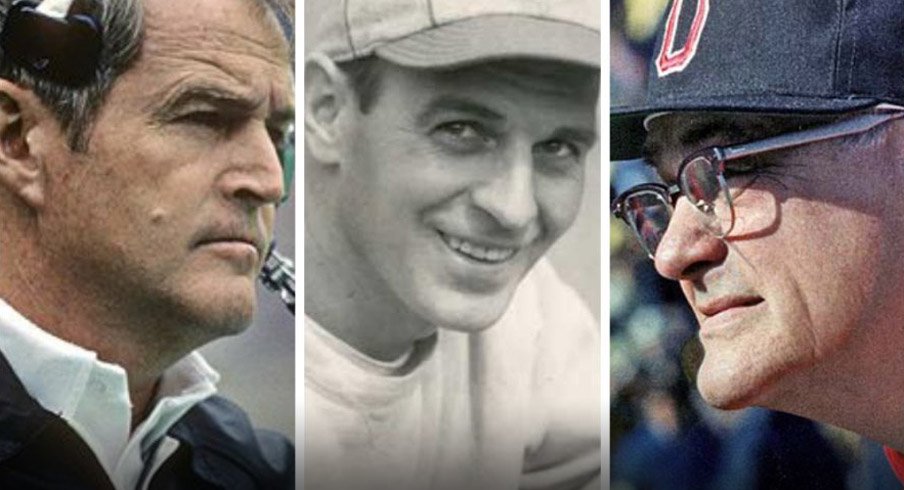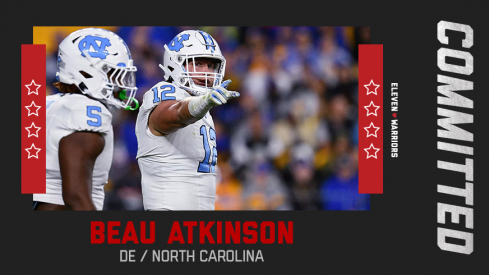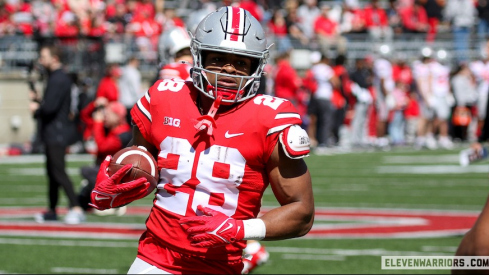Football lost a coaching legend, Friday, but Chuck Noll's legacy will live on.
Noll passed away at 82 years old and, naturally, as football fans, we reflect on his indelible career. Perhaps the greatest compliment to the former Steelers' coach is the respect he earned from his biggest rivals. As his career record indicates, he was no friend to Ohioans, but is still embraced by the state that produced him.
In that sense, he was like Bo Schembechler (with more than zero championships), another Ohio native who went on to have success with the state's biggest football rival. The Buckeye State was generous enough to let those two slip outside of its borders, but that's a reflection on the coaching talent that stayed in state.
While Urban Meyer escaped to Utah and Florida for 8 seasons, the Ashtabula native returned to lead the Buckeyes in 2012.
"Growing up in Ohio, Fridays were high school football, Saturdays were Ohio State and Sundays were the Browns and Bengals and really nothing else," Meyer said, prior to the 2008 national title game against Youngstown's Bob Stoops. "In the offseason, you played basketball and baseball to stay in shape for football. Did that have an impact on my life? Absolutely."
That mentality is pervasive, part of the reason why Ohio is the undoubted mecca of football – not just because it's the birthplace of modern, professional football. Noll, Schembechler, Meyer and Stoops are part of a rich coaching history in Ohio, one that is unrivaled by the other 49 states.
It was difficult to trim this list to only 10, and even tougher to rank them. Regardless, here are the best Ohio has had to offer:
Notable exceptions
Jim Harbaugh, John Heisman, Don James, Larry Kehres, Bob Stoops.
10. Les Miles
If his career continues on the same path, time might shift his place in these rankings.
Like most successful "Michigan Men," Les Miles is actually from Ohio. The Elyria native played for Bo Schembechler and was an offensive line coach under Gary Moeller. He's been tempted to return since leaving in 1994 (just ask Kirk Herbstreit), but has stayed in the south.
His first head coaching experience came at Oklahoma State, which ended after a 2004 Alamo Bowl loss to Ohio State. He stepped into a perfect situation at LSU, inheriting Nick Saban's team, and has only won less than 10 games in a season twice. His career record stands at 123-45, with one national title, and has still managed to field dominant teams in a wildly competitive SEC.
9. ARA PARSEGHIAN
For someone to barely creep over .500 in a major college football conference and land the Notre Dame job was unprecedented in his time.
Now, following Tyrone Willingham and Charlie Weis, it's almost expected of the Fighting Irish. Back when Ara Parseghian accepted the job, after going 36-35-1 in eight seasons at Northwestern, he returned to Miami University first. He was not a Notre Dame graduate nor was he catholic, but Parseghian quickly won the trust of fans by going 9-1 in his first season.
The Akron native finished his career with two national titles (1966 and 1973) and, even more everlasting, changed the culture of Notre Dame. Parseghian established the modern navy uniforms and a reinvigorated rivalry with Michigan.
8. Lou Holtz
His legacy may be defined by sitting next to Mark May and appearing in Discover Card commercials.
Before that, however, Holtz jumped around from college to college, putting out fires (on the field) and starting new ones (NCAA violations) right before he left. Still, the wide range of success is the reason why he's on this list – other than growing up in East Liverpool.
Holtz went 33-12-3 at N.C. State, then was tempted by offers from Tulane and the New York Jets, which he ultimately accepted. His one-year stint in the NFL failed, and he returned to Arkansas, which hasn't been nearly as successful since his departure (sorry, Bert). He won 60 games at Arkansas and was curiously fired after a 6-5 season. Holtz then went to Minnesota, and left due to a "Notre Dame clause" in his contract.
The Irish's last period of unquestioned success occurred under Holtz, who led them to the 1988 national championship and went 100-30-2 in 11 seasons. Once again, he left under peculiar circumstances, only to return to coaching at South Carolina in 1999.
7. Bo Schembechler
Countless books and TV series' have chronicled Bo Schembechler's impact on Michigan, the rivalry and college football, in general.
Yet, his only failure was never winning a national title, which is why he's so low on this list. The Barberton native was an Ohio guy through and through, playing for Woody Hayes at Miami Univerisity, coaching under Hayes at Ohio State and returning to Miami to lead the Redskins.
After compiling a 40-17-3 record in Oxford, he challenged his mentor by accepting the Michigan job in 1969. That immediately ignited the "Ten Year War," catapulting the series against the Buckeyes into, what many consider, the greatest rivalry in sports. Schembechler went 5-4-1 against Hayes and 11-9-1 against OSU, overall.
He never had a losing season at Michigan, consistency which would be much appreciated in modern times. Nothing could have been more poignant than his passing, a day before the much-hyped 2006 game.
6. Urban Meyer
The prodigal son returned to Ohio in 2012 after an incredible amount of leaving the cupboard bare success elsewhere.
Meyer, born in Toledo and raised in Ashtabula, shot up the coaching ladder with stints at Bowling Green (17-6) and Utah (22-2, including an undefeated 2004 campaign). He was not the inventor nor the sole innovator of the modern spread offense movement, but he's the undisputed leader, considering the amount of wins he's piled up.
We know about the 2006 national championship season, and, on top of that, won a title with his recruits (and Tim Tebow) in 2008. Over 12 seasons, he's only lost more than four games in a season once. His .837 winning percentage is the highest of any active Division-I coach (with at least 10 full seasons) and continuing this streak of success at Ohio State only seems inevitable, assuming he doesn't flame out again.
5. Jim Tressel
Now that he's the president of Youngstown State, there's no quantifying what Jim Tressel's impact could be in his home state.
On the field, the Mentor native racked up accomplishments that few in his profession have similarly achieved. Combined with his time as head coach at Youngstown State, he's won five national titles. Until 2001, he rebuffed many opportunities to jump to the (formerly known as) Division I-A level, and only chose to leave for the state's flagship university.
At Ohio State, Tressel led the school to its first national championship since 1970 and won a Big Ten title in seven of his 10 seasons (yes, 2010 still counts). He won, at least, 10 games and finished in the final top 10 poll in each of his last six seasons. You could say he was just hitting his stride before "resigning" in 2011.
4. Chuck Noll
As this list proves, Ohio has an incredibly rich tradition producing college head coaches.
The state's professional head coaches aren't as storied, but it doesn't get any better than the best Ohio has to offer. Lou Holtz's one season with the Jets notwithstanding, Knoll is the first professional coach to appear in the top 10. Born in Cleveland, Noll attended Benedictine and the University of Dayton before the Browns drafted him in 1953.
He was an assistant coach for the Chargers and Colts before heading to Pittsburgh. There, Noll, along with Terry Bradshaw and the "Steel Curtain" defense he helped build, turned the Steelers into an enemy of the state (or destination for bandwagon jumpers). With Pittsburgh, Noll won four Super Bowls, more than any other head coach, and amassed 193 wins. The Steelers organization has been a model of consistency ever since Noll arrived.
3. Don Shula
No professional head coach has more wins than Don Shula.
As if that wasn't enough to cement his legacy, he won two Super Bowls (VII and VIII) and was the head coach of the last team to remain undefeated throughout the season. Considering the longevity – 33 seasons as head coach of the Colts and Dolphins – Shula's 328 career wins might not be surpassed.
The Grand River native is alive, at 84 years old, and has a chain of decent steakhouses on top of his accomplishments in the game of football.
2. Woody Hayes
There is no greater Ohio State coach than Wayne Woodrow Hayes.
He may not have been wanted by Buckeye fans at the beginning of his tenure – the No. 1 guy on this list was a top choice – but, in the end, Hayes' career is unmatched by fellow OSU coaches.
Like a few on this list, the Clifton native incubated at the University of Miami ("Cradle of Coaches") before being named head coach at Ohio State, prior to the 1951 season. Hayes ripped off an incredible run, winning five national titles and 205 games in Columbus. His legacy endured through a spectacular flameout, largely because he won a Big Ten title in nine of his final 11 seasons. That culmination of a legendary coaching career included the "Ten Year War" and two national titles.
1. Paul Brown
Born in Norwalk and raised in Massillon, no one had a greater impact on football in the state of Ohio.
Excluding two years, each, with Severn School (Maryland) and the Great Lakes Blue Jackets, Brown spent nearly his entire career coaching in Ohio. He led his hometown Massillon Tigers and helped turn them into the prep powerhouse they are now. At Massillon, he invented the playbook and originated the practice of sending plays from the sidelines via hand signals.
After Massillon, Ohio State hired him and he led the Buckeyes to the 1942 National Championship. Undoubtedly, his greatest accomplishments in the state were his involvement in founding the Cleveland Browns (7 time champions, in multiple leagues), which still bares his name, and the Cincinnati Bengals, whose stadium is named after him. On an entirely different level, the structure of his staff within those organizations were revolutionary and, to a large degree, NFL franchises are still modeled after him.
Modern football, particularly in Ohio, would have a different feel if not for Brown.


